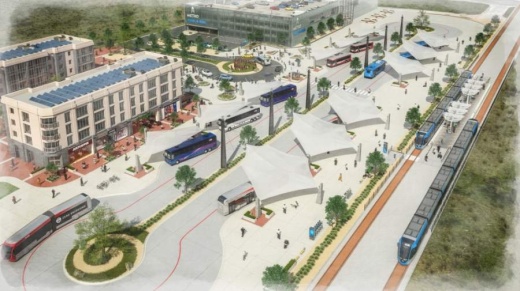The plan, called Project Connect, would add two light rail lines connecting downtown to the Austin-Bergstrom International Airport and areas of North Austin and South Austin, among other expansions.
Capital Metro President and CEO Randy Clarke and Assistant City Manager Gina Fiandaca said in a May 6 memo to City Council and the transit agency's board of directors that Capital Metro staff have tweaked that initial plan.
The updated Project Connect plans now include a third light rail line, which would run between downtown and the Austin Community College Highland Campus, passing by St. David’s Medical Center, the east side of the University of Texas campus and the Texas Capitol.
In the Project Connect plans, Cap Metro calls this 6-mile route the Gold Line. It was included in Capital Metro’s March presentation to council and the board, but initially, staff envisioned it as a bus line in a dedicated lane.
Dave Couch, Capital Metro program officer for Project Connect, said staffers are still working their way through cost projections related to the change. Couch also said the final construction timeline is still to come. It will have to be sequenced after the underground tunnel downtown presented in March that would connect the three rail lines.
In the memo, Clarke and Fiandaca said the adjustment was made due to new population projections along the corridor.
The Capital Area Metropolitan Planning Organization, a board made up of local government officials in Central Texas, voted May 4 on a 25-year plan for transportation projects based upon a study of demographic trends through 2045.
According to the memo, that demographic modeling “supports the need for increased ridership capacity,” which can be achieved by switching the Gold Line to light rail instead of bus rapid transit.
However, some elected officials expressed reservations about the 2045 Plan ahead of CAMPO’s May 4 vote of approval.
Austin City Council Member Jimmy Flannigan, who was one of two no votes on the plan, said he was concerned about demographic projections as well as about the uncertainty of revenue sources.
“This plan is not terribly substantive because it’s on the eve of a census, so the data is pretty significantly flawed just because of the timeline it’s based on,” Flannigan said.
Couch said that the demographic data from CAMPO is part of a mandated process from the Federal Transit Administration and that Capital Metro always expected to adjust its modeling after CAMPO approved its 2045 plan with updated demographics.
"We fully expected there were going to be some kind of changes," he said.
Cap Metro staff also adjusted plans along the existing commuter rail line, the Red Line, which runs between Leander and downtown Austin. According to the memo, $380 million of planned work was scrapped because it did not lead to enough additional ridership to justify the cost over 30 years.
A 40% share of the Project Connect plan is expected to be funded by the federal government, leaving about $5.6 billion to be paid locally.
The financing method for that local portion of the project has not been finalized. However, officials have discussed a tax rate election in November asking voters for permission to increase year-over-year revenue in the fiscal year 2020-21 city budget above 3.5%, the revenue cap instituted by state lawmakers in 2019.
The impact to taxpayers would vary based on construction timelines. For the median homeowner of a $325,000 property, according to data presented March 9, that tax impact could range from $18-$37 per month,
It is unclear how the coronavirus pandemic and the economic uncertainty it caused for both public organizations and local residents will affect those financing options presented in March. For now, Capital Metro is focusing on providing essential trips to the community through the coronavirus pandemic while keeping an eye to the future, Couch said.
The public transit agency will unveil a virtual open house on its website May 7 that will allow visitors to receive as much detail as they want—from a high-level overview to a granular section-by-section look at the plan.
Capital Metro will also hold virtual community meetings ahead of a June 10 joint session between its board of directors and Austin City Council. At that meeting, according to Couch, Capital Metro will work to finalize the technical aspects of the plan.





